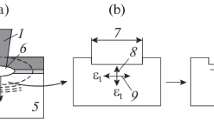Abstract
Laser shock-wave processing of materials is a modern technology for effective processing of metallic materials. In the near-surface region, the processing produces significant compressive residual stresses that contribute to increasing material strength and improving their tribological and operational characteristics. In this work, we performed finite element modeling of the laser shock-wave technology using the intrinsic deformation method. Specifically, using the intrinsic deformation method, we first solved the dynamic problem on the impact of a shock load and determined the distribution of stabilized plastic deformations (so-called “intrinsic deformations”) and then solved the static problem on the elastic response of the system to the intrinsic deformations induced into it. The level of the resulting compressive residual stresses arising upon laser shock-wave processing is determined. The obtained results correlated well with the known experimental data.
Similar content being viewed by others
References
Peyre, P., Berthe, L., Vignal, V., Popa, I., and Baudin, T., Analysis of laser shock waves and resulting surface deformations in an Al–Cu–Li aluminum alloy, J. Phys. D: Appl. Phys., 2012, vol. 45, pp. 35–42.
Morales, M., Ocaña, J.L., Molpeceres, C., Porro, J.A., and García–Beltrán, A., Model based optimization criteria for the generation of deep compressive residual stress fields in high elastic limit metallic alloys by ns–laser shock processing, Surf. Coat. Technol., 2008, vol. 202, no. 11, pp. 2257–2262.
Reissner, H., Eigenspannungen und Eigenspannungsquellen, Z. Angew. Math. Mech., 1931, vol. 11, pp. 1–8.
Mura, T., Micromechanics of Defects in Solids, 2nd ed., Dordrecht: Kluwer Academic, 1991.
Lokhov, V.A. and Tuktamyshev, V.S., Investigation of stress–free condigions in the system with intrinsic deformation, Izv. Vyssh. Uchebn. Zaved., Povolzh. Reg., Fiz.–Mat. Nauki, 2013, no. 2 (26), pp. 198–207.
Korsunsky, A.M., Residual elastic strain due to laser shock peening: modelling by eigenstrain distribution, J. Strain Anal. Eng. Des., 2006, vol. 41, no. 3, pp. 195–204.
Jun, T.S. and Korsunsky, A.M., Evaluation of residual stresses and strains using the eigenstrain reconstruction method, Int. J. Solids Struct., 2010, vol. 47, no. 13, pp. 1678–1686.
DeWald, A.T. and Hill, M.R., Eigenstrain–based model for prediction of laser peening residual stresses in arbitrary three–dimensional bodies, Part 1: Model description, J. Strain Anal. Eng. Des., 2009, vol. 44, pp. 1–11.
Sakhvadze, G.Zh. and Gavrilina, L.V., Single and multiple laser shock processing of materials, J. Mach. Manuf. Reliab., 2015, vol. 44, no. 6, pp. 549–554.
Sakhvadze, G.Zh., Gavrilina, L.V., and Kikvidze, O.G., Influence of laser spot overlap effect on residual stresses during laser–shock–wave processing of materials, J. Mach. Manuf. Reliab., 2016, vol. 45, no. 3, pp. 258–265.
Sakhvadze, G.Zh., Bulekbaeva, G.Zh., and Kikvidze, O.G., Research of surface layers quality hardening by laser shock processing at different rates of laser spots overlapping, Probl. Mashinostr. Avtomatiz., 2016, no. 2, pp. 132–141.
Sakhvadze, G.Zh., Bulekbaeva, G.Zh., and Kikvidze, O.G., Application features of two–sided laser shock processing technology for thin structures, Probl. Mashinostr. Avtomatiz., 2016, no. 3, pp. 127–138.
Sakhvadze, G.Zh., Pugachev, M.S., and Kikvidze, O.G., Features of strengthening of materials by laser shock processing, Uprochn. Tekhnol. Pokryt., 2016, no. 9 (141), pp. 20–25.
Sakhvadze, G.Zh., Pugachev, M.S., and Kikvidze, O.G., Technology of two–sided laser–impact–wave processing of materials, Russ. Eng. Res., 2017, vol. 37, no. 1, pp. 40–45.
Sakhvadze, G., Shokhin, A., and Kikvidze, O., Residual stresses distribution in ti–6al–4v titanium alloys during laser shock processing, Vibroeng. Proc., 2016, vol. 8, pp. 422–427.
Achintha, M., Nowell, D., Shapiro, K., and Withers, P.J., Eigenstrain modelling of residual stresses generated by arrays of laser peening shots and determination of the complete stress field using limited strain measurements, J. Surf. Coat. Technol., 2013, vol. 216, pp. 68–77.
Author information
Authors and Affiliations
Corresponding author
Additional information
Original Russian Text © G.Zh. Sakhvadze, 2018, published in Problemy Mashinostroeniya i Nadezhnosti Mashin, 2018, No. 4.
About this article
Cite this article
Sakhvadze, G.Z. Features of Finite Element Modeling of Residual Stresses Arising in Material under Laser Shock-Wave Processing Using the Intrinsic Deformations Method. J. Mach. Manuf. Reliab. 47, 373–379 (2018). https://doi.org/10.3103/S105261881804012X
Received:
Published:
Issue Date:
DOI: https://doi.org/10.3103/S105261881804012X



